Reactive PLIF Method for Characterisation of Micromixing in Continuous High-Throughput Chemical Reactors
Abstract
1. Introduction
- Measurement of temperature fields in a gas-stirred ladle [20];
- Study of the coolant mixing in reactor vessel down-comer [21];
- Characterisation of interphase mass transfer of immiscible liquid–liquid system in a stirred tank [22];
- Measurement of solute-induced Marangoni effect of a growing drop [23];
- Characterisation of mixing efficiency in particle-laden Taylor–Couette flows [24].
2. Experimental Section
2.1. Test-Reactions
2.2. Experimental Procedure—Study of the Test-Reactions
2.3. Experimental Procedure—Validation of Test-Reaction in a T-Jet Mixer
- −
- Segregated or stratified flow regime—a steady flow regime where each side of the mixing chamber contains mainly one of the fluids. The fluid stream flows from the jets to the outlet delimited by the segregation plane that coincides with the mixing chamber axis and is normal to the inlet’s axes [62,63,64].
- −
- −
- −
- Chaotic flow regime—this flow regime is characterised by the formation of a vortex street, resembling a von Karman vortex street, consisting of the shedding of vortices from the opposed jet impingement point, which evolves throughout the mixing chamber, promoting the fast mixing of the fluid streams (Sultan et al., 2012) [62].
3. Results
3.1. AB-RPLIF Method
3.2. Oxi-RPLIF Method
4. Techno-Economic Analysis of AB-RPLIF and Oxi-RPLIF Methods
5. Conclusions
Author Contributions
Funding
Informed Consent Statement
Data Availability Statement
Conflicts of Interest
References
- Liu, Z.; Cheng, Y.; Jin, Y. Experimental study of reactive mixing in a mini-scale mixer by laser-induced fluorescence technique. Chem. Eng. J. 2009, 150, 536–543. [Google Scholar] [CrossRef]
- Lehwald, A.; Thévenin, D.; Zähringer, K. Quantifying macro-mixing and micro-mixing in a static mixer using two-tracer laser-induced fluorescence. Exp. Fluids 2010, 48, 823–836. [Google Scholar] [CrossRef]
- Cheng, J.; Feng, X.; Cheng, D.; Yang, C. Retrospect and Perspective of Micro-mixing Studies in Stirred Tanks. Chin. J. Chem. Eng. 2012, 20, 178–190. [Google Scholar] [CrossRef]
- Nadeau, P.; Berk, D.; Munz, R.J. Measurement of residence time distribution by laser absorption spectroscopy. Chem. Eng. Sci. 1996, 51, 2607–2612. [Google Scholar] [CrossRef][Green Version]
- Buchmann, M.; Mewes, D. Measurement of the local intensities of segregation with the tomographical dual wavelength photometry. Can. J. Chem. Eng. 1998, 76, 626–630. [Google Scholar] [CrossRef]
- Buchmann, M.; Mewes, D. Tomographic Measurements of Micro-and Macromixing using the Dual Wavelength Photometry. Chem. Eng. J. 2000, 77, 3–9. [Google Scholar] [CrossRef]
- Baldyga, J.; Bourne, J.R. Turbulent Mixing and Chemical Reactions, 1st ed.; John Wiley and Sons: Hoboken, NJ, USA, 1999. [Google Scholar]
- Jasińska, M. Test Reactions to Study Efficiency of Mixing. Chem. Process Eng. 2015, 36, 171–208. [Google Scholar] [CrossRef]
- Dewey, C.F., Jr. Qualitative and quantitative flow field visualization utilizing laser-induced fluorescence. In Proceedings of the Applications of Non-Intrusive Instrumentation in Fluid Flow Research, Saint-Louis, France, 1 May 1976. [Google Scholar]
- Owen, K. Simultaneous laser measurements of instantaneous velocity and concentration in turbulent mixing flows. In Proceedings of the Applications of Non-Intrusive Instrumentation in Fluid Flow Research, Saint-Louis, France, 30 April 1976. [Google Scholar]
- Liu, H.T.; Lin, J.T.; Delisi, D.P.; Robben, F.A. Application of a fluorescence technique to dye-concentration measurements in a turbulent jet. In Proceedings of the Symposium on Flow Measurement in Open Channels and Closed Conduits, Gaithersburg, MA, USA, 23–25 February 1977; pp. 423–446. [Google Scholar]
- Walker, D.A. A fluorescence technique for measurement of concentration in mixing liquids. J. Phys. E Sci. Instrum. 1987, 20, 217–224. [Google Scholar] [CrossRef]
- Bruchhausen, M.; Guillard, F.; Lemoine, F. Instantaneous measurement of two-dimensional temperature distributions by means of two-color planar laser induced fluorescence (PLIF). Exp. Fluids 2005, 38, 123–131. [Google Scholar] [CrossRef]
- Hu, Y.; Liu, Z.; Yang, J.; Jin, Y.; Cheng, Y. Study on the reactive mixing process in an unbaffled stirred tank using planar laser-induced fluorescence (PLIF) technique. Chem. Eng. Sci. 2010, 65, 4511–4518. [Google Scholar] [CrossRef]
- Webster, D.R.; Roberts, P.J.W.; Ra’ad, L. Simultaneous DPTV/PLIF measurements of a turbulent jet. Exp. Fluids 2001, 30, 65–72. [Google Scholar] [CrossRef]
- Milton-McGurk, L.; Williamson, N.; Armfield, S.W.; Kirkpatrick, M.P. Experimental investigation into turbulent negatively buoyant jets using combined PIV and PLIF measurements. Int. J. Heat Fluid Flow 2020, 82, 108561. [Google Scholar] [CrossRef]
- Melton, L.A.; Lipp, C.W. Criteria for quantitative PLIF experiments using high-power lasers. Exp. Fluids 2003, 35, 310–316. [Google Scholar] [CrossRef]
- Sakakibara, J.; Hishida, K.; Maeda, M. Measurements of thermally stratified pipe flow using image-processing techniques. Exp. Fluids 1993, 16, 82–96. [Google Scholar] [CrossRef]
- Kuzkova, N.; Popenko, O.; Yakunov, A. Application of Temperature-Dependent Fluorescent Dyes to the Measurement of Millimeter Wave Absorption in Water Applied to Biomedical Experiments. Int. J. Biomed. Imaging 2014, 2014, 243564. [Google Scholar] [CrossRef] [PubMed]
- Jardón-Pérez, L.E.; Amaro-Villeda, A.M.; Trápaga-Martínez, G.; González-Rivera, C.; Ramírez-Argáez, M.A. Utilization of the Planar Laser-Induced Fluorescence Technique (PLIF) to Measure Temperature Fields in a Gas-Stirred Ladle. Metall. Mater. Trans. A 2020, 51, 2510–2521. [Google Scholar] [CrossRef]
- Eltayeb, A.; Tan, S.; Qi, Z.; Ala, A.A.; Ahmed, N.M. PLIF experimental validation of a FLUENT CFD model of a coolant mixing in reactor vessel down-comer. Ann. Nucl. Energy 2019, 128, 190–202. [Google Scholar] [CrossRef]
- Du, X.; Duan, X.; Yang, C. Visual Study on the Interphase Mass Transfer of Immiscible Liquid–Liquid System in a Stirred Tank. Ind. Eng. Chem. Res. 2019, 58, 21785–21796. [Google Scholar] [CrossRef]
- Wang, Z.; Chen, J.; Feng, X.; Mao, Z.-S.; Yang, C. Visual dynamical measurement of the solute-induced Marangoni effect of a growing drop with a PLIF method. Chem. Eng. Sci. 2021, 233, 116401. [Google Scholar] [CrossRef]
- Rida, Z.; Cazin, S.; Lamadie, F.; Dherbécourt, D.; Charton, S.; Climent, E. Experimental investigation of mixing efficiency in particle-laden Taylor–Couette flows. Exp. Fluids 2019, 60, 61. [Google Scholar] [CrossRef]
- Fitschen, J.; Hofmann, S.; Wutz, J.; Kameke, A.v.; Hoffmann, M.; Wucherpfennig, T.; Schlüter, M. Novel evaluation method to determine the local mixing time distribution in stirred tank reactors. Chem. Eng. Sci. X 2021, 10, 100098. [Google Scholar] [CrossRef]
- Rodriguez, G.; Micheletti, M.; Ducci, A. Macro- and micro-scale mixing in a shaken bioreactor for fluids of high viscosity. Chem. Eng. Res. Des. 2018, 132, 890–901. [Google Scholar] [CrossRef]
- Eltayeb, A.; Tan, S.; Ala, A.A.; Zhang, Q. The study of the influence of slug density on the mixing performance in the reactor vessel, using PLIF experiment and FLUENT simulation. Prog. Nucl. Energy 2021, 131, 103558. [Google Scholar] [CrossRef]
- Duan, X.; Feng, X.; Mao, Z.-S.; Yang, C. Numerical simulation of reactive mixing process in a stirred reactor with the DQMOM-IEM model. Chem. Eng. J. 2019, 360, 1177–1187. [Google Scholar] [CrossRef]
- Taghavi, M.; Moghaddas, J. Using PLIF/PIV techniques to investigate the reactive mixing in stirred tank reactors with Rushton and pitched blade turbines. Chem. Eng. Res. Des. 2019, 151, 190–206. [Google Scholar] [CrossRef]
- Hu, Y.; Wang, W.; Shao, T.; Yang, J.; Cheng, Y. Visualization of reactive and non-reactive mixing processes in a stirred tank using planar laser induced fluorescence (PLIF) technique. Chem. Eng. Res. Des. 2012, 90, 524–533. [Google Scholar] [CrossRef]
- Bourne, J.R. Mixing and the Selectivity of Chemical Reactions. Process Res. Dev. 2003, 7, 471–508. [Google Scholar] [CrossRef]
- Bourne, J.R.; Kut, O.M.; Lenzner, J.; Maire, H. Kinetics of the diazo coupling between 1-naphthol and diazotized sulfanilic acid. Ind. Eng. Chem. Res. 1990, 29, 1761–1765. [Google Scholar] [CrossRef]
- Nunes, M.; Santos, R.; Dias, M.; Lopes, J.C. Micromixing assessment of confined impinging jet mixers used in RIM. Chem. Eng. Sci. 2012, 74, 276–286. [Google Scholar] [CrossRef]
- Meyer, T.; Fleury, P.A.; Renken, A.; Darbellay, J.; Larpin, P. Barium sulfate precipitation as model reaction for segregation studies at pilot scale. Chem. Eng. Process. 1992, 31, 307–310. [Google Scholar] [CrossRef][Green Version]
- Barthole, J.P.; David, R.; Molleyre, J.F.; Bourrret, P.; Villermaux, J.J.J.C.P. Cinétique macroscopique de la précipitation du sulfate de baryum en présence d’EDTA. J. Chim. Phys. 1982, 79, 719–724. [Google Scholar] [CrossRef]
- Bourne, J.R.; Kozicki, F. Mixing Effects During the Bromination of 1,3,5-trimethoxybenzene. Chem. Eng. Sci. 1977, 32, 1538–1539. [Google Scholar] [CrossRef]
- Hecht, K.; Koelbl, A.; Kraut, M.; Schubert, K. Micromixer Characterization with Competitive-Consecutive Bromination of 1,3,5-Trimethoxybenzene. Chem. Eng. Technol. 2008, 31, 1176–1181. [Google Scholar] [CrossRef]
- Oates, P.M.; Harvey, C.F. A colorimetric reaction to quantify fluid mixing. Exp. Fluids 2006, 41, 673–683. [Google Scholar] [CrossRef]
- Zhang, P.; DeVries, S.L.; Dathe, A.; Bagtzoglou, A.C. Enhanced Mixing and Plume Containment in Porous Media under Time-Dependent Oscillatory Flow. Environ. Sci. Technol. 2009, 43, 6283–6288. [Google Scholar] [CrossRef] [PubMed]
- Akiti, O. Turbulent Mixing and Chemical Reaction in Baffled Stirred Tank Reactors: A Comparison between Experiments and a Novel Micromixing-Based Computational Fluid Dynamics Model; New Jersey Institute of Technology: Newark, NJ, USA, 2000. [Google Scholar]
- Baldyga, J.; Henczka, M.; Makowski, L. Effects of Mixing on Parallel Chemical Reactions in a Continuous-Flow Stirred-Tank Reactor. Chem. Eng. Res. Des. 2001, 79, 895–900. [Google Scholar] [CrossRef]
- Bałdyga, J.; Bourne, J.R.; Hearn, S.J. Interaction between chemical reactions and mixing on various scales. Chem. Eng. Sci. 1997, 52, 457–466. [Google Scholar] [CrossRef]
- Bourne, J.R.; Yu, S. Investigation of micromixing in stirred tank reactors using parallel reactions. Ind. Eng. Chem. Res. 1994, 33, 41–55. [Google Scholar] [CrossRef]
- Baldyga, J.; Bourne, J.R. The effect of micromixing on parallel reactions. Chem. Eng. Sci. 1990, 45, 907–916. [Google Scholar] [CrossRef]
- Tolgyesi, W.S. Relative reactivity of toluene-benzene in nitronium tetrafluoroborate nitration—Limitation of the competitive method of rate determination in fast reactions. Can. J. Chem. 1964, 43, 343–355. [Google Scholar] [CrossRef]
- Baldyga, J.; Jasinska, M.; Trendowska, J.; Tadeusiak, W.; Cooke, M.; Kowalski, A. Application of Test Reactions to Study Micromixing and Mass Transfer in Chemical Apparatus. 2012. Available online: https://suw.biblos.pk.edu.pl/resourceDetailsBPP&rId=14358 (accessed on 28 June 2022).
- Fournier, M.C.; Falk, L.; Villermaux, J. A new parallel competing reaction system for assessing micromixing efficiency—Experimental approach. Chem. Eng. Sci. 1996, 51, 5053–5064. [Google Scholar] [CrossRef]
- Guichardon, P.; Falk, L. Characterisation of micromixing efficiency by the iodide–iodate reaction system. Part I: Experimental procedure. Chem. Eng. Sci. 2000, 55, 4233–4243. [Google Scholar] [CrossRef]
- Ghanem, A.; Lemenand, T.; Della Valle, D.; Peerhossaini, H. Static mixers: Mechanisms, applications, and characterization methods—A review. Chem. Eng. Res. Des. 2014, 92, 205–228. [Google Scholar] [CrossRef]
- Baldyga, J.; Bourne, J.R.; Walker, B. Non-isothermal micromixing in turbulent liquids: Theory and experiment. Can. J. Chem. Eng. 1998, 76, 641–649. [Google Scholar] [CrossRef]
- Faes, M.; Glasmacher, B. Measurements of micro- and macromixing in liquid mixtures of reacting components using two-colour laser induced fluorescence. Chem. Eng. Sci. 2008, 63, 4649–4655. [Google Scholar] [CrossRef]
- Kling, K.; Mewes, D. Two-colour laser induced fluorescence for the quantification of micro- and macromixing in stirred vessels. Chem. Eng. Sci. 2004, 59, 1523–1528. [Google Scholar] [CrossRef]
- Wheat, P.M.; Posner, J.D. Quantifying mixing using equilibrium reactions. Phys. Fluids 2009, 21, 037101. [Google Scholar] [CrossRef]
- Lehwald, A.; Jenrich, S.; Thévenin, D.; Zahrinque, K. Experimental investigation of macro- and micro-mixing in a reactive turbulent channel flow. In Proceedings of the 16th International Symposium on Applications of Laser Techniques to Fluid Mechanics, Lisbon, Portugal, 20–23 July 1992; pp. 1–10. [Google Scholar]
- Lehwald, A.; Thévenin, D.; Zähringer, K. Simultaneous two-tracer-Laser-induced fluorescence and particle image velocimetry for the investigation of macro-and micro-mixing in a static mixer. In Proceedings of the 15th International Symposium on Applications of Laser Techniques to Fluid Mechanics, Lisbon, Portugal, 5–8 July 2010. [Google Scholar]
- Fall, A.; Lecoq, O.; David, R. Characterization of Mixing in a Stirred Tank by Planar Laser Induced Fluorescence (P.L.I.F.). Chem. Eng. Res. Des. 2001, 79, 876–882. [Google Scholar] [CrossRef][Green Version]
- Rule, G.; Seitz, W.R. Flow-injection analysis with chemiluminescence detection. Clin. Chem. 1979, 25, 1635–1638. [Google Scholar] [CrossRef]
- Shamsipur, M.; Chaichi, M.J.; Karami, A.R. A study of peroxyoxalate-chemiluminescence of acriflavine. Spectrochim. Acta A Mol. Biomol. Spectrosc. Spectrochim. Acta A 2003, 59, 511–517. [Google Scholar] [CrossRef]
- Jonsson, T.; Irgum, K. Very fast peroxyoxalate chemiluminescence. Anal. Chim. Acta 1999, 400, 257–264. [Google Scholar] [CrossRef]
- Karasso, P.S.; Mungal, M.G. PLIF measurements in aqueous flows using the Nd:YAG laser. Exp. Fluids 1997, 23, 382–387. [Google Scholar] [CrossRef]
- Mortensen, M.; Orciuch, W.; Bouaifi, M.; Andersson, B. Mixing of a Jet in a Pipe. Chem. Eng. Res. Des. 2004, 82, 357–363. [Google Scholar] [CrossRef]
- Sultan, M.A.; Fonte, C.P.; Dias, M.M.; Lopes, J.C.B.; Santos, R.J. Experimental study of flow regime and mixing in T-jets mixers. Chem. Eng. Sci. 2012, 73, 388–399. [Google Scholar] [CrossRef]
- Bothe, D.; Stemich, C.; Warnecke, H.-J. Computation of scales and quality of mixing in a T-shaped microreactor. Comput. Chem. Eng. 2008, 32, 108–114. [Google Scholar] [CrossRef]
- Soleymani, A.; Kolehmainen, E.; Turunen, I. Numerical and experimental investigations of liquid mixing in T-type micromixers. Chem. Eng. J. 2008, 135, S219–S228. [Google Scholar] [CrossRef]
- Mariotti, A.; Galletti, C.; Mauri, R.; Salvetti, M.V.; Brunazzi, E. Steady and unsteady regimes in a T-shaped micro-mixer: Synergic experimental and numerical investigation. Chem. Eng. J. 2018, 341, 414–431. [Google Scholar] [CrossRef]
- Soleymani, A.; Yousefi, H.; Turunen, I. Dimensionless number for identification of flow patterns inside a T-micromixer. Chem. Eng. Sci. 2008, 63, 5291–5297. [Google Scholar] [CrossRef]
- Zhang, J.-W.; Liu, S.-F.; Cheng, C.; Li, W.-F.; Xu, X.-L.; Liu, H.-F.; Wang, F.-C. Investigation of three-dimensional flow regime and mixing characteristic in T-jet reactor. Chem. Eng. J. 2019, 358, 1561–1573. [Google Scholar] [CrossRef]
- Sultan, M.A.; Krupa, K.; Fonte, C.P.; Nunes, M.I.; Dias, M.M.; Lopes, J.C.B.; Santos, R.J. High-Throughput T-Jets Mixers: An Innovative Scale-Up Concept. Chem. Eng. Technol. 2013, 36, 323–331. [Google Scholar] [CrossRef]
- Coppeta, J.; Rogers, C. Dual emission laser induced fluorescence for direct planar scalar behavior measurements. Exp. Fluids 1998, 25, 1–15. [Google Scholar] [CrossRef]
- Koochesfahani, M.M. Experiments on Turbulent Mixing and Chemical Reactions in a Liquid Mixing Layer; California Institute of Technology: Pasadena, CA, USA, 1984. [Google Scholar]
- Koochesfahani, M.M.; Dimotakis, P.E. Mixing and chemical reactions in a turbulent liquid mixing layer. J. Fluid Mech. 1986, 170, 83–112. [Google Scholar] [CrossRef]
- Kola, L.; Amataj, S. The influence of some chemical and physical parameters of water samples on spectral determinations of fluorescent dyes. Maced. J. Chem. Chem. Eng. 2006, 25, 107–112. [Google Scholar]
- Santos, R.J.; Sultan, M.A. State of the Art of Mini/Micro Jet Reactors. Chem. Eng. Technol. 2013, 36, 937–949. [Google Scholar] [CrossRef]
- Hoffmann, M.; Schlüter, M.; Räbiger, N. Experimental investigation of liquid–liquid mixing in T-shaped micro-mixers using μ-LIF and μ-PIV. Chem. Eng. Sci. 2006, 61, 2968–2976. [Google Scholar] [CrossRef]
- Sultan, M.A.; Pardilhó, S.L.; Brito, M.S.C.A.; Fonte, C.P.; Dias, M.M.; Lopes, J.C.B.; Santos, R.J. 3D Mixing Dynamics in T-Jet Mixers. Chem. Eng. Technol. 2019, 42, 119–128. [Google Scholar] [CrossRef]
- Crimaldi, J.P. Planar laser induced fluorescence in aqueous flows. Exp. Fluids 2008, 44, 851–863. [Google Scholar] [CrossRef]
- Ottino, J.M.; Ranz, W.E.; Macosko, C.W. A lamellar model for analysis of liquid-liquid mixing. Chem. Eng. Sci. 1979, 34, 877–890. [Google Scholar] [CrossRef]
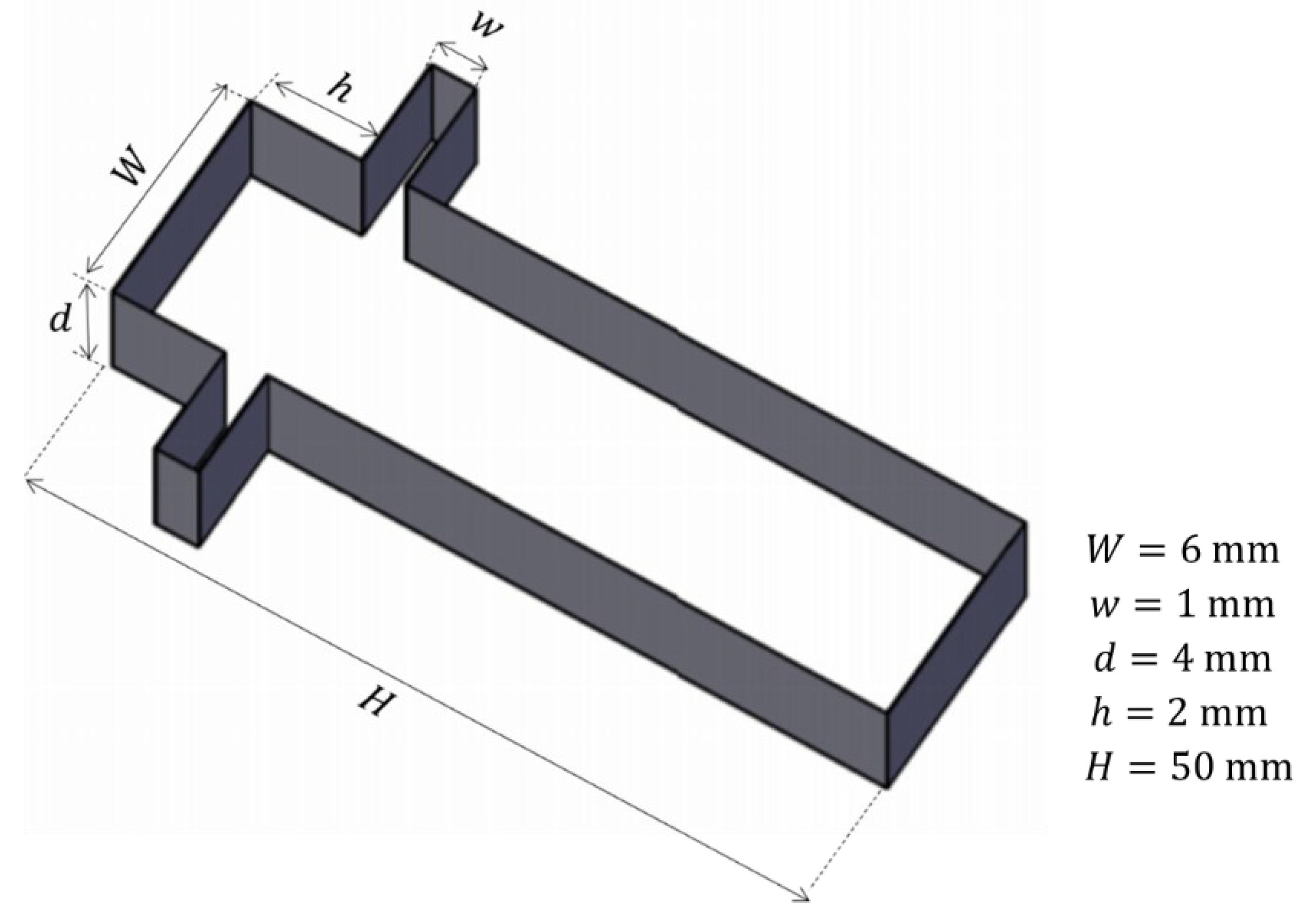
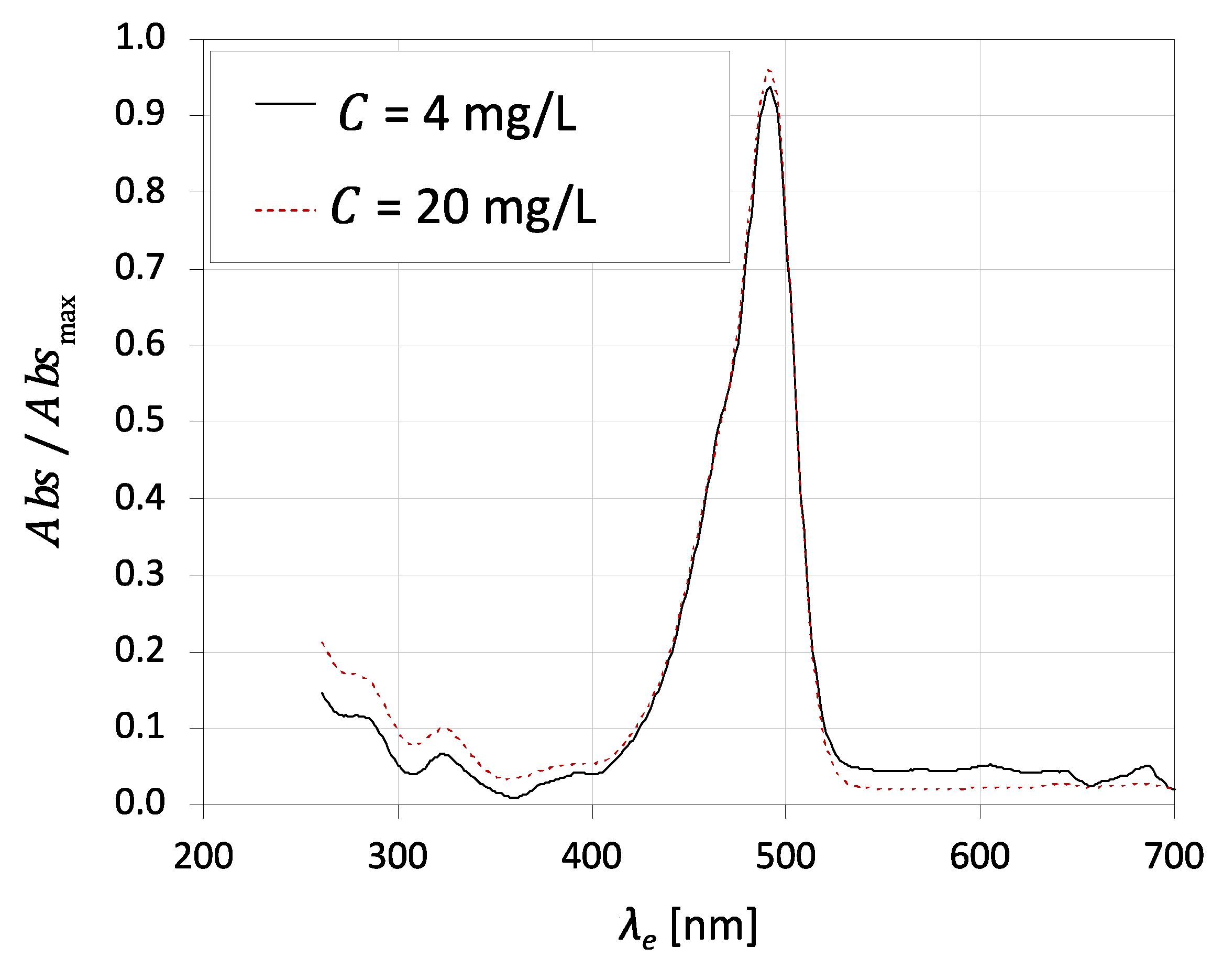

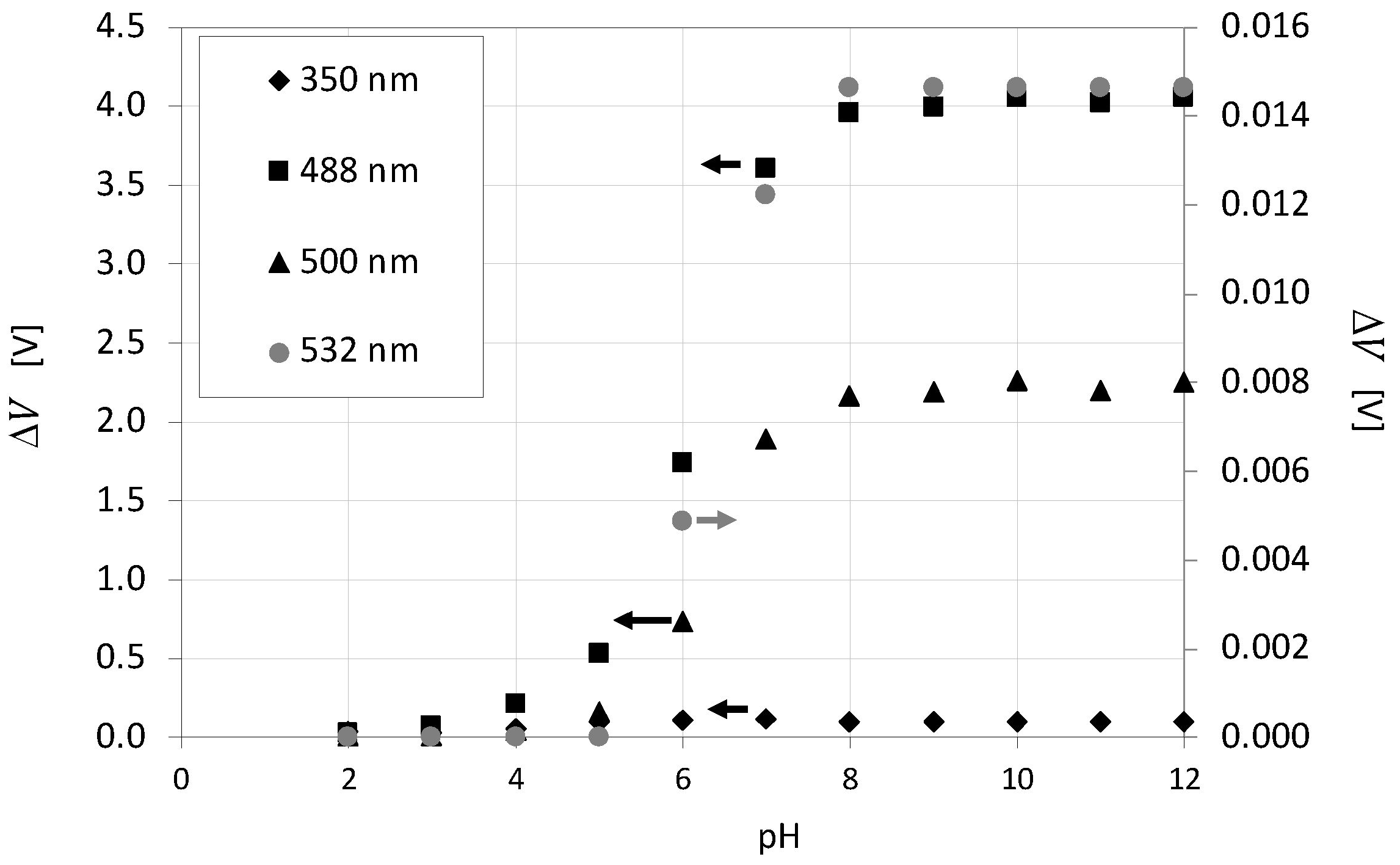
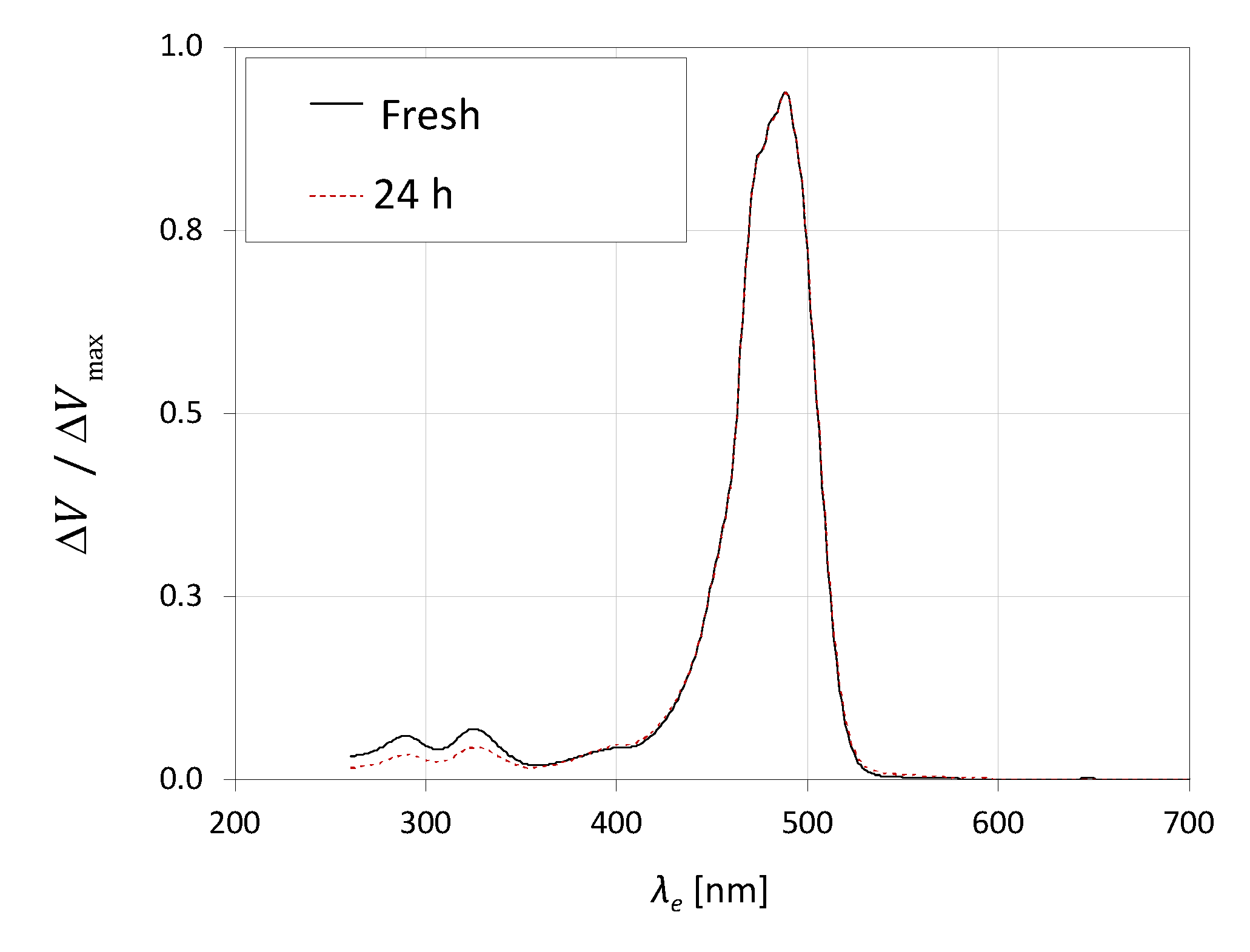
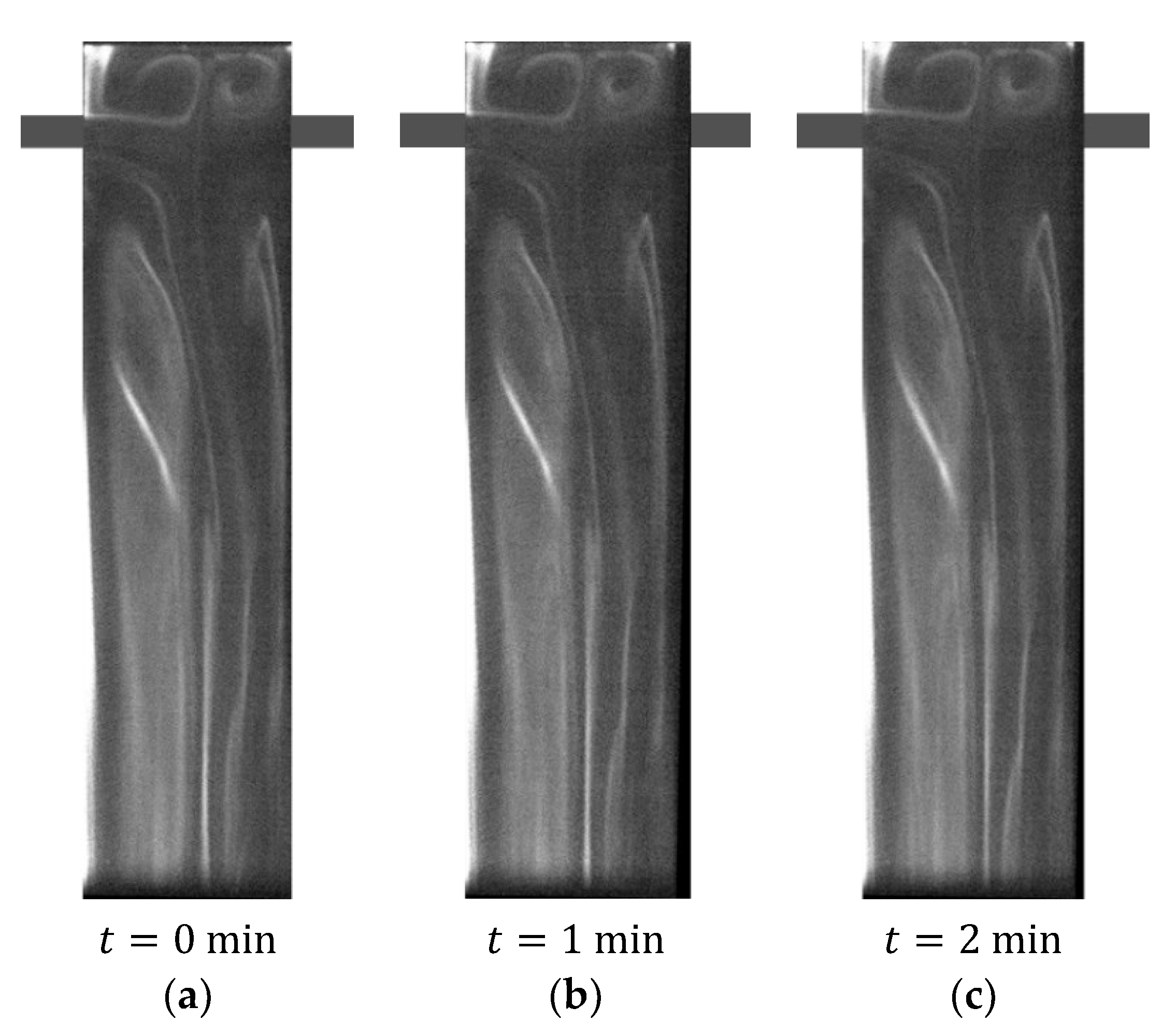


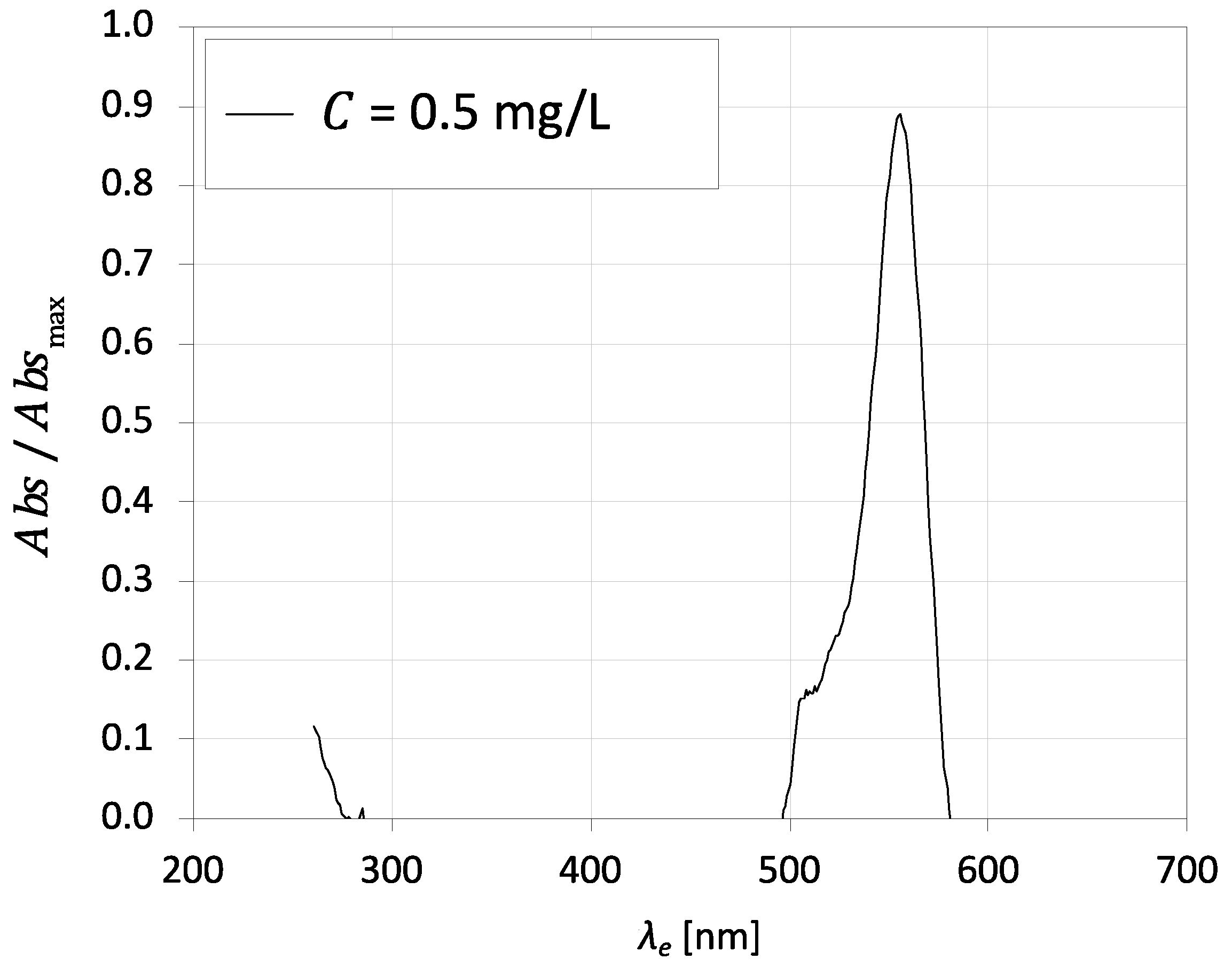

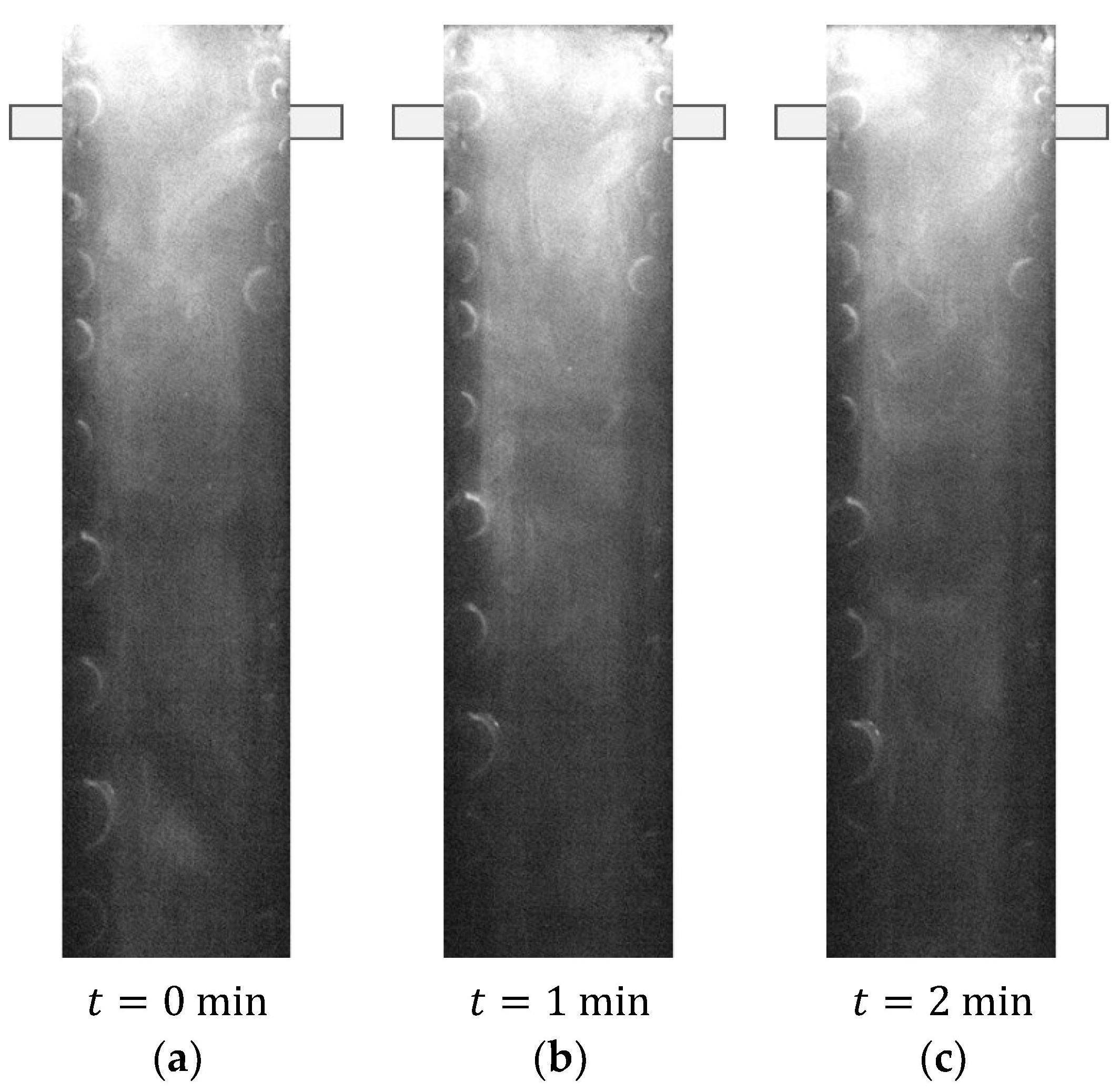
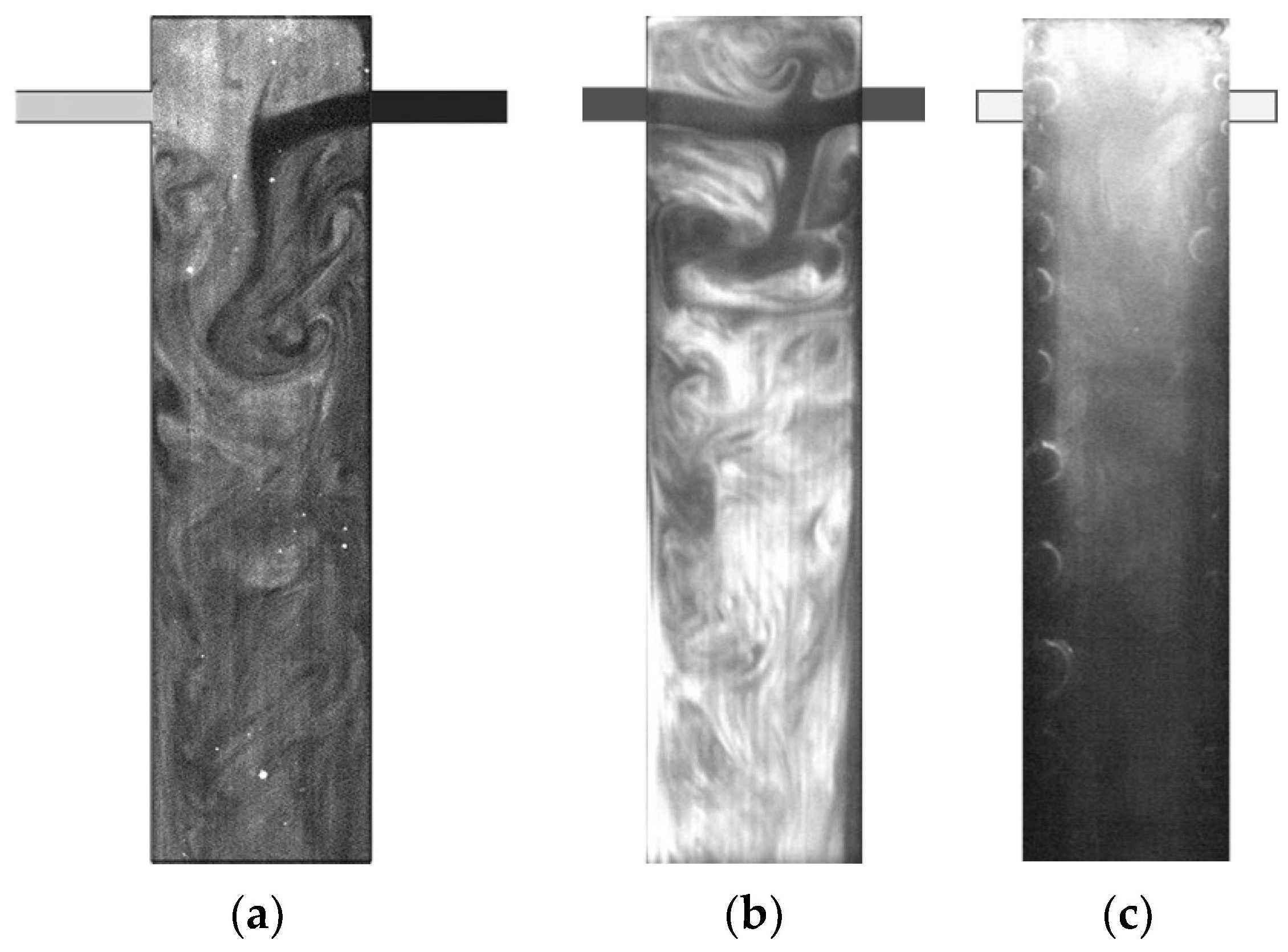
| Reagent A | Reagent B | Kinetic Rate Constant (25 °C) | Reference | Analytical Method |
|---|---|---|---|---|
| (m3·mol−1·s−1) | ||||
| 1- and 2-naphtol (A1 and A2) | Diazotised sulphanilic acid | k1 = 1.3 × 104; k2 = 2.7 | Bourne [31], Bourne, et al. [32] Nunes, et al. [33] | A1 + B → R B + R → S A2 + B → Q B is the limiting reagent, and A is buffered to pH = 9.9 (usually Na2CO3/NaHCO3); absorption spectrophotometry technique used for measurement of the products over time, at λmax, which are 510 nm for R, 560 nm for S and 480 nm for Q. |
| Alkaline solution of BaCI2, NaOH, Na2SO4 and EDTA | HCl | k1 = 1.8 × 108 k2 = not reported | Meyer, et al. [34], Barthole, et al. [35] | Absorption spectrophotometry technique. Mixing of the reagents takes place in stirred tanks. After the injection of B into A, a representative sample is taken, and absorbance of precipitate product BaSO4 is measured at 650 nm. |
| 1,3,5-Trimetoxybenzene (TMB) | Bromine | k1/k2 ≈ 27 | Bourne and Kozicki [36] Bourne [31] and Hecht, et al. [37] | High-performance liquid chromatography technique. TMB and bromine flow from different streams and downstream from the mixer (different types of mixers tested); an HPLC device is used to analyse the products, separating TMB, product R and product S. |
| Mo− as (NH4)2MoO4 | Ti2+ (tiron as disodium salt) | Oates and Harvey [38], Zhang, et al. [39] | Absorption spectrophotometry and absorbance imaging techniques. Absorbance at 580 nm was measured in samples taken downstream from the mixer. Additionally, polychromatic absorbance was measured in a glass mixing chamber by means of a CCD camera. Then, the absorbance over the visual spectrum, which is what the digital camera observes, was compared to the absorbance at 580 nm. |
| Reagent A | Reagent B | Reagent C | Kinetic Rate Constant (25 °C) | Reference | Analytical Method |
|---|---|---|---|---|---|
| (m3·mol−1·s−1) | |||||
| Hydrochloric acid | Sodium hydroxide | Ethyl mono-chloro-acetate | k1 = 1.3–1.4 × 108; k2 = 0.023–0.031 | Akiti [40], Bourne [31] Baldyga, et al. [41], Bałdyga, et al. [42], Bourne and Yu [43] | Chromatographic analysis. Reagents A and C are pre-mixed in a mixing vessel, and then B is added. Samples are taken from the stirred tank and analysed for product distribution by either gas chromatography [40] or HPLC [41]. Test-reaction reported for low turbulence in the tank, with dissipation rate as low as 0.018 W·kg−1 [42]. |
| Iron sulphate | Sodium hydroxide | Ethyl mono-chloro-acetate | k1 = 107; k2 = 0.023 | Baldyga and Bourne [44] | Titration. Limiting reagent B is added to a tank containing reagents A and C. The concentration of ferric ions still present in solution after reaction (not precipitated as ferric hydroxide) is found by titration with EDTA in the presence of salicylic acid at pH ≈ 3. |
| Benzene | NO2+ (as NO2BF4) | Toluene | k1/k2 = 27 | Baldyga and Bourne [44], Tolgyesi [45] | Gas chromatography technique. B is added to an equimolar mixture of A and C in a stirred tank. After reaction is complete, samples are taken from the batch reactor, and the distribution of products between nitrobenzene and nitrotoluene is measured by gas chromatography. |
| Benzoic acid | Sodium hydroxide | Ethyl chloro-acetate | k1 → ∞; k2 = 0.023 | Jasińska [8], Baldyga, et al. [46] | Chromatographic analysis by one of two methodologies: (a) B is added to a mixture of A and C in a batch mixer. After reaction is complete, samples are taken, and concentration of ester and/or by-product ethanol is measured by either GC or HPLC [46]. (b) A solution of A and C in toluene is added to B in a batch mixer. After reaction is complete, concentrations of ethanol and ethyl chloroacetate are measured by gas chromatography [8,46]. |
| Borate ion (boric acid) | Sulphuric acid | Iodide and iodate | k1 = 108; k2 = f (I), I = ionic strength | Hecht, et al. [37], Fournier, et al. [47], Guichardon and Falk [48], Ghanem, et al. [49] | H2BO3− + H+ ⇔ H3BO3 5I− + IO3− + 6H+ ⇔ 3I2 + 3H2O I2 + I− ⇔ I3− Absorption spectrophotometry technique. Iodate and iodide are added into a stirred tank. Sodium hydroxide is added before boric acid to prevent the formation of iodine in acid medium. When the reagents are supposed to be mixed, sulphuric acid is added into the stirred tank. The analysis of the solution is performed by spectrophotometry at 353 nm within a minute after the end of reaction: samples taken two minutes after the acid injection [48]. |
| Sodium hydroxide | HCl | 2,2-dimethoxy-propane | k1 = 1.3–1.4 × 108; k2 = 0.6 | Bourne [31], Baldyga, et al. [50] | Chromatographic analysis. HCl is added to a solution of alkali and acetal in a 1:10 ratio (v/v). According to Baldyga et al. [46], equal molar quantities of acid and acetal should be used with a 5% excess of alkali to ensure the stability of the unreacted acetal when all the acid has been neutralised. Mixing performed in a stirred tank, with analysis of product mixtures performed by gas chromatography. |
| Reagent A | Reagent B | Reagent C | Kinetic Rate Constant (25 °C) | Reference | Analytical Method |
|---|---|---|---|---|---|
| (m3·mol−1·s−1) | |||||
| Ca2+ ions (CaCl2) | Fluo-4—reactive dye | Carboxy-SNARF-inert dye | k = 106 | Faes and Glasmacher [51], Kling and Mewes [52], Wheat and Posner [53] | Fluo-4 + CaCl2 → Fluo-4.Ca (with emission increase) LIF technique. A mix of the two dyes is injected into the mixing vessel containing CaCl2, which turns on the Fluo-4 fluorescence; excitation light source: pulsed laser with λ = 495 nm; emitted light detected with a CCD camera at 516 nm for Fluo-4 and 645 nm for Carboxy-SNARF. |
| Acid–base (HCl + NaOH) | Uranine (reactive dye) | Pyridine-2 (inert dye) | Quasi-instantaneous, k → ∞ | Lehwald, et al. [2], Lehwald, et al. [54], Lehwald, et al. [55] | HCl + NaOH ⇔ NaCl + H2O @ pH = 7 Uranine’s emission E = f(pH) LIF technique. Mixtures of water + acid + uranine + pyridine 2 (Flow 1) and water+base+uranine (Flow 2) flow to a mixer where they are illuminated at 532 nm; emitted light detected by means of CCD cameras, at 550 nm for uranine and 705 nm for pyridine-2. Reported results refer to laminar regime. |
| Fe2+ ions – as (NH4)2Fe(SO4)2 | Rhodamine B, RhB | Hydrogen peroxide, H2O2 | k1 = 0.1; k2 = 104–107 | Liu, et al. [1], Hu, et al. [14], Hu, et al. [30]. | Fe2+ + H2O2 ⇔ OH● OH● + RhB → M (quenching of the fluorescence) LIF technique. The fluorescent dye is dissolved in one of the reagent streams so that when they mix, the reaction quenches the fluorescent signal; light source wavelength: 532 nm; emitted light detected at 590 nm by means of CCD camera; reported measurements performed online in mini-scale Y-jet mixers [1] or in unbaffled stirred tanks [14,30]. |
| Water | Water + Rhodamine B | NA | NA | Fall, et al. [56] | LIF technique. The fluorescent dye is dissolved in one of the two water flows that will be illuminated; light source wavelength: 520 nm. Emitted light detected at 590 nm by means of a CCD camera; measurements reported performed online in a cylindrical stirred tank. |
| Cu (II) in NH3-NH4+ buffer (pH = 11) | Luminol | Hydrogen peroxide, H2O2 | Rule and Seitz [57] | C8H7O3N3 + Cu(II) + H2O2 → 3-aminophtalate + hν Chemiluminescence detection. The reagent flows are injected into the detection cell. No light source is needed; emitted light detected with a photomultiplier tube at 420–450 nm; measurements reported were performed online in a coil of Teflon tube that is pressed against the PMT detector; laminar regime. | |
| bis-(2,4,6-trichlorophenyl)oxalate TCPO | Acriflavine | Hydrogen peroxide, H2O2 | Shamsipur, et al. [58] | TCPO + H2O2 → C2O4 + 2 [C6HOCl3] C2O4 + acriflavine → 2CO2 + acriflavine → 2CO2 + acriflvine + hν Chemiluminescence detection; reagents are mixed in a stirred glass mixer; no light source needed; emitted light detected online by means of a photocell at 510–540 nm. | |
| bis-(2,4,6-trichlorophenyl)oxalate TCPO | 3-aminofluoranthene (3-AFA) | Hydrogen peroxide, H2O2 + base catalyst | Jonsson and Irgum [59] | TCPO + H2O2 → C2O4 + 2 [C6HOCl3] C2O4 + 3-AFA → 2CO2 + 3-AFA * → 2CO2 + 3-AFA + hν Chemiluminescence detection; no light source needed; emitted light detected with a photomultiplier tube at 518 nm; measurements reported were performed online in stopped-flow equipment. |
| Assay | Objective | C (mg·L−1) | pH | Time of Measurements |
|---|---|---|---|---|
| F1 | Absorption spectrum | 4; 20 | 7 | Immediately after preparation |
| F2 | Linearity dynamic range of fluorescence | 4–30 | 7 | Immediately after preparation |
| F3 | pH effect on emission | 20 | 2–12 | Immediately after preparation |
| F4 | Fluorophore stability | 20 | 2 | Immediately after preparation and 24 h after preparation |
| RhB1 | Absorption spectrum | 0.5 | Immediately after preparation | |
| RhB2 | Fluorophore stability | 0.5 | Immediately after preparation and 24 h after preparation |
Publisher’s Note: MDPI stays neutral with regard to jurisdictional claims in published maps and institutional affiliations. |
© 2022 by the authors. Licensee MDPI, Basel, Switzerland. This article is an open access article distributed under the terms and conditions of the Creative Commons Attribution (CC BY) license (https://creativecommons.org/licenses/by/4.0/).
Share and Cite
Ribeiro, J.P.; Brito, M.S.C.A.; Santos, R.J.; Nunes, M.I. Reactive PLIF Method for Characterisation of Micromixing in Continuous High-Throughput Chemical Reactors. Processes 2022, 10, 1916. https://doi.org/10.3390/pr10101916
Ribeiro JP, Brito MSCA, Santos RJ, Nunes MI. Reactive PLIF Method for Characterisation of Micromixing in Continuous High-Throughput Chemical Reactors. Processes. 2022; 10(10):1916. https://doi.org/10.3390/pr10101916
Chicago/Turabian StyleRibeiro, João Peres, Margarida S. C. A. Brito, Ricardo Jorge Santos, and Maria Isabel Nunes. 2022. "Reactive PLIF Method for Characterisation of Micromixing in Continuous High-Throughput Chemical Reactors" Processes 10, no. 10: 1916. https://doi.org/10.3390/pr10101916
APA StyleRibeiro, J. P., Brito, M. S. C. A., Santos, R. J., & Nunes, M. I. (2022). Reactive PLIF Method for Characterisation of Micromixing in Continuous High-Throughput Chemical Reactors. Processes, 10(10), 1916. https://doi.org/10.3390/pr10101916







